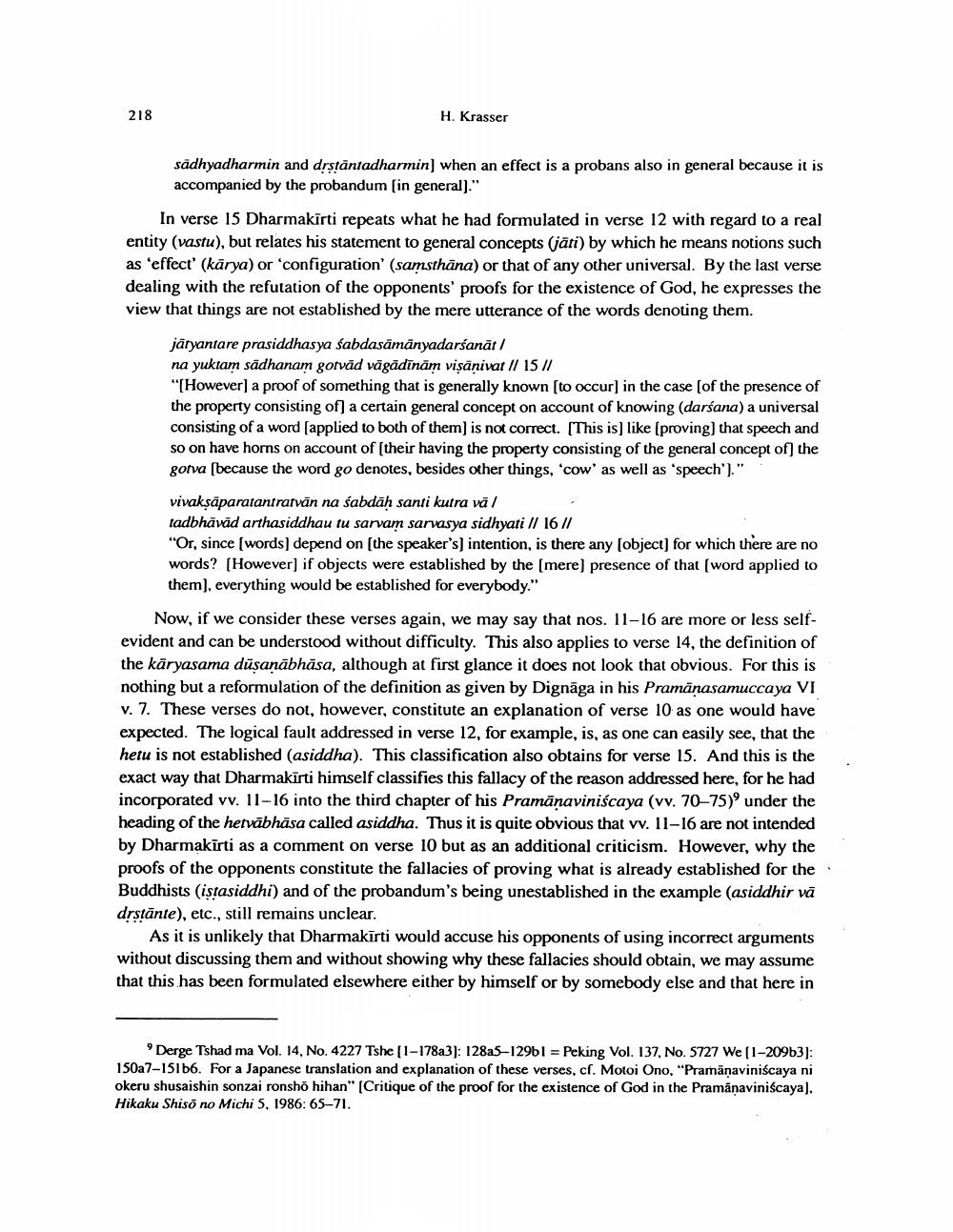Book Title: Dharmakirtis And Kumarilas Refutations Of Existence Of God Author(s): Helmut Krasser Publisher: Helmut Krasser View full book textPage 4
________________ 218 H. Krasser sadhyadharmin and drstäntadharmin) when an effect is a probans also in general because it is accompanied by the probandum (in general)." In verse 15 Dharmakirti repeats what he had formulated in verse 12 with regard to a real entity (vastu), but relates his statement to general concepts (jāti) by which he means notions such as 'effect' (kārya) or 'configuration' (samsthāna) or that of any other universal. By the last verse dealing with the refutation of the opponents' proofs for the existence of God, he expresses the view that things are not established by the mere utterance of the words denoting them. järyantare prasiddhasya sabdasämänyadarśanāt / na yuktam sādhanam gotvād vāgādinām visānivar // 15 // "[However) a proof of something that is generally known (to occur) in the case (of the presence of the property consisting of] a certain general concept on account of knowing (darśana) a universal consisting of a word (applied to both of them) is not correct. (This is) like (proving) that speech and so on have horns on account of their having the property consisting of the general concept of the gotva (because the word go denotes, besides other things, 'cow' as well as 'speech')." vivaksāparatantratvān na sabdah santi kutra vā / tadbhävad arthasiddhau tu sarvam sarvasya sidhyati // 16 // "Or, since (words) depend on the speaker's) intention, is there any (object) for which there are no words? (However) if objects were established by the (mere) presence of that (word applied to them), everything would be established for everybody." Now, if we consider these verses again, we may say that nos. 11-16 are more or less selfevident and can be understood without difficulty. This also applies to verse 14, the definition of the kāryasama dūsanābhāsa, although at first glance it does not look that obvious. For this is nothing but a reformulation of the definition as given by Dignāga in his Pramānasamuccaya VI v. 7. These verses do not, however, constitute an explanation of verse 10 as one would have expected. The logical fault addressed in verse 12, for example, is, as one can easily see, that the hetu is not established (asiddha). This classification also obtains for verse 15. And this is the exact way that Dharmakīrti himself classifies this fallacy of the reason addressed here, for he had incorporated vv. 11-16 into the third chapter of his Pramānaviniscaya (vv. 70–75) under the heading of the hetvābhāsa called asiddha. Thus it is quite obvious that vv. 11-16 are not intended by Dharmakīrti as a comment on verse 10 but as an additional criticism. However, why the proofs of the opponents constitute the fallacies of proving what is already established for the Buddhists (istasiddhi) and of the probandum's being unestablished in the example (asiddhir vā drstānte), etc., still remains unclear. As it is unlikely that Dharmakīrti would accuse his opponents of using incorrect arguments without discussing them and without showing why these fallacies should obtain, we may assume that this has been formulated elsewhere either by himself or by somebody else and that here in Derge Tshad ma Vol. 14, No. 4227 Tshe (1-178a3): 12825-129b1 = Peking Vol. 137, No. 5727 We(1-20963): 150a7-15166. For a Japanese translation and explanation of these verses, cf. Motoi Ono, "Pramāņaviniscaya ni okeru shusaishin sonzai ronsho hihan" (Critique of the proof for the existence of God in the Pramānaviniscaya). Hikaku Shiso no Michi 5, 1986: 65–71.Page Navigation
1 2 3 4 5 6 7 8 9
